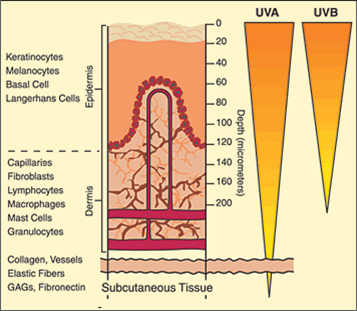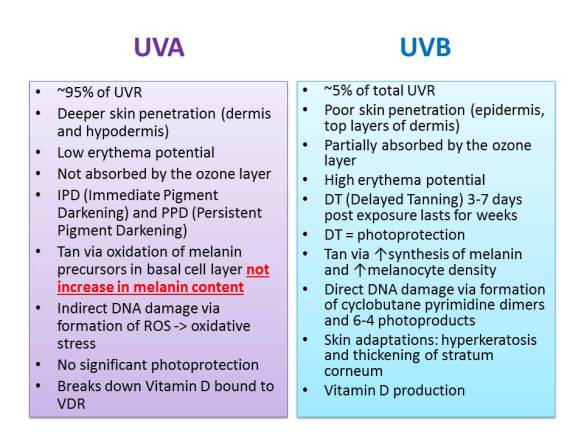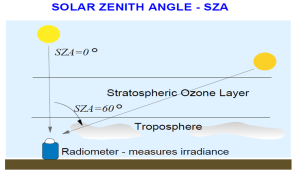Following on from my previous post on the inanity of anti-sun public health campaigns, I wanted to discuss a few aspects of sunlight itself and pathophysiology of melanoma.
Here is the story so far:
- the relationship between sunlight and melanoma is complicated. Genes matter (your family history), your phenotype (skin and eye colour) can be a risk factor, but the environment also seems to play a large role.
- there is no linear relationship between exposure and melanoma. Zero exposure over a lifetime will probably guarantee no melanoma (I’ll leave it up to you if you would like to spend your life hidden inside because let’s face it, what could possibly go wrong?) But beyond that, the picture is sketchy. Less exposure does not mean less melanoma. Chronic UV exposure has been repeatedly shown to be protective.
- in spite of widespread and very successful health campaigns which focus on one single risk factor (sunlight) the incidence of melanoma is rising.
- while it is tempting to reduce exposure to minimum in an attempt to mitigate risk, the lack of sun exposure is a significant problem on its own. I won’t go into too much detail here, but vitamin D deficiency (which is estimated to affect 1/3 of Australians) is only a part of the picture.
Sunlight is frequently referred to as some homogenous substance in the same way that all fat is apparently the same because each gram contains the same number of calories. However, just like lauric acid (a medium chain saturated fat) is processed in your body completely differently from palmitic (long chain saturated) or DHA (long chain omega-3), different wavelengths of solar spectrum have varying effects on our physiology.
UV radiation is only a part of solar spectrum, with wavelengths between those of X-rays and visible light. Its unique effect on biological systems stems from the ability of the photon to break chemical bonds. UVR is further divided into UVA (the longest wavelength at 400 – 315 nm), UVB (315 – 280 nm) and UVC (280 – 100 nm). While the shorter wavelengths of UVC and UVB are most damaging to biological entities like human cells, they are also filtered by our ozone layer. In normal run of things UVC is completely blocked with none of it reaching the Earth’s surface. UVB is blocked partially with the rate of absorption proportional to the length the photon travels through the ozone layer. If you got a little lost in the last sentence here is the gist. If the sun was directly over your head and the sun rays were falling at 90 degrees to the surface of the Earth (this is considered Solar Zenith Angle of zero), photons would have to travel the shortest distance through the ozone layer and more UVB radiation would reach the surface. If the direction of the radiation is at 45 degrees to the surface, more ozone is encountered on the way and less UVB gets to the surface.
Ok, with maths out of the way let’s get to the nitty gritty of what is different between UVA and UVB.

While UVB is a stronger partner being able to cause direct damage to DNA, it is also the one that has less penetration. In fact, very little is able to penetrate down to the basal cell layer where melanocytes live.

What is this “photoprotection” I am talking about? Amazingly enough, after millions of years under that yellow orb our bodies did not wait for the invention of sunscreens. Instead, we have evolved multiple ways to protect ourselves. Locally in the skin, there are two major mechanisms of photoprotection.
UVB used to get a lot of bad rap. And who could blame the scientists doing in vitro experiments and seeing DNA molecules unravel, the sequence misread, uncontrolled proliferation initiated – all in response to UVB. In fact, we have done everything we could to eliminate our exposure to UVB rays full stop. SPF rating of sunscreen applies to its ability to prevent erythema, aka burn. Therefore it reflects how much UVB it can block (UVB being the erythematogenic partner).
UVA remained under the radar for a while. Solariums used to be advertised as “safer than the sun” because UVA was predominantly used. Now UVA is coming more under suspicion for being the culprit behind melanoma. How to tease out which is which? For starters, scientists like to use some poor animals to prove their theories.
It is hard to believe but we haven’t got very decent animal models of melanoma. Well, there is this fish which got melanoma after being irradiated with UVA.
Another crucial component to add to the mix is Vitamin D.
Without going to far into this massive topic, I will just mention that it is one of our main immunomodulators, both preventing DNA damage and initiating repair and/or apoptosis (programmed cell death) when necessary. Its active form, 1.25(OH)2D, is protective against UVR-induced photocarcinogenesis. In diagnosed melanoma, Vitamin D levels and pre-cancer skin exposure are predictive of survival. Not forgetting that UVA does not lead to vitamin D synthesis. In fact, it can break it down when it is attached to the vitamin D receptor (VDR). You need UVB in order to synthesise Vitamin D in your skin.
So here you go. When it comes to sunlight, things are not always what they seem. Focusing our full attention to blocking ALL sunlight to protect ourselves, we may have unwittingly increased our UVA to UVB ratio.
UVA and UVB imbalance is a neat hypothesis. It resolves some of the apparent paradoxes relating to sunlight and melanoma, the paradoxes that conventional wisdom desperately tries to ignore.
To summarise: what are the effects of receiving too much UVA and not enough UVB?
So do we still think that there is not such thing as safe tan? Or that sunscreens will save us all?
Here is the story so far:
- the relationship between sunlight and melanoma is complicated. Genes matter (your family history), your phenotype (skin and eye colour) can be a risk factor, but the environment also seems to play a large role.
- there is no linear relationship between exposure and melanoma. Zero exposure over a lifetime will probably guarantee no melanoma (I’ll leave it up to you if you would like to spend your life hidden inside because let’s face it, what could possibly go wrong?) But beyond that, the picture is sketchy. Less exposure does not mean less melanoma. Chronic UV exposure has been repeatedly shown to be protective.
- in spite of widespread and very successful health campaigns which focus on one single risk factor (sunlight) the incidence of melanoma is rising.
- while it is tempting to reduce exposure to minimum in an attempt to mitigate risk, the lack of sun exposure is a significant problem on its own. I won’t go into too much detail here, but vitamin D deficiency (which is estimated to affect 1/3 of Australians) is only a part of the picture.
Sunlight is frequently referred to as some homogenous substance in the same way that all fat is apparently the same because each gram contains the same number of calories. However, just like lauric acid (a medium chain saturated fat) is processed in your body completely differently from palmitic (long chain saturated) or DHA (long chain omega-3), different wavelengths of solar spectrum have varying effects on our physiology.
UV radiation is only a part of solar spectrum, with wavelengths between those of X-rays and visible light. Its unique effect on biological systems stems from the ability of the photon to break chemical bonds. UVR is further divided into UVA (the longest wavelength at 400 – 315 nm), UVB (315 – 280 nm) and UVC (280 – 100 nm). While the shorter wavelengths of UVC and UVB are most damaging to biological entities like human cells, they are also filtered by our ozone layer. In normal run of things UVC is completely blocked with none of it reaching the Earth’s surface. UVB is blocked partially with the rate of absorption proportional to the length the photon travels through the ozone layer. If you got a little lost in the last sentence here is the gist. If the sun was directly over your head and the sun rays were falling at 90 degrees to the surface of the Earth (this is considered Solar Zenith Angle of zero), photons would have to travel the shortest distance through the ozone layer and more UVB radiation would reach the surface. If the direction of the radiation is at 45 degrees to the surface, more ozone is encountered on the way and less UVB gets to the surface.
Ok, with maths out of the way let’s get to the nitty gritty of what is different between UVA and UVB.

While UVB is a stronger partner being able to cause direct damage to DNA, it is also the one that has less penetration. In fact, very little is able to penetrate down to the basal cell layer where melanocytes live.

What is this “photoprotection” I am talking about? Amazingly enough, after millions of years under that yellow orb our bodies did not wait for the invention of sunscreens. Instead, we have evolved multiple ways to protect ourselves. Locally in the skin, there are two major mechanisms of photoprotection.
- Skin thickening. Sounds too simple to be effective but it does in fact work, especially in preventing UVB penetration. This effect is mediated most strongly by UVB itself and manifests in thickening of stratum corneum.
- Melanin production. Melanin is a substance produced by the melanocytes in the basal cell layer. It absorb UVR as it passes through the skin and prevents further damage. It is an excellent defender against both UVA and UVB rays. The initial DNA signal is required for the initiation of melanin production. Here is where the differences between UVA and UVB are most striking. Even though the tan produced by UVA and UVB looks identical, its origins are different. UVA does not increase total content of melanin in the skin, it just releases pre-made melanin from the melanocytes and oxidises it. UVB, on the other hand, stimulates melanin production.
UVB used to get a lot of bad rap. And who could blame the scientists doing in vitro experiments and seeing DNA molecules unravel, the sequence misread, uncontrolled proliferation initiated – all in response to UVB. In fact, we have done everything we could to eliminate our exposure to UVB rays full stop. SPF rating of sunscreen applies to its ability to prevent erythema, aka burn. Therefore it reflects how much UVB it can block (UVB being the erythematogenic partner).
UVA remained under the radar for a while. Solariums used to be advertised as “safer than the sun” because UVA was predominantly used. Now UVA is coming more under suspicion for being the culprit behind melanoma. How to tease out which is which? For starters, scientists like to use some poor animals to prove their theories.
It is hard to believe but we haven’t got very decent animal models of melanoma. Well, there is this fish which got melanoma after being irradiated with UVA.
…an alternate action spectrum that is more heavily weighted to the longer wavelengths, including UVA and visible light, has been found in the platyfish-swordtail hybryd model of melanoma, which suggests that UVA is a much more potent inducer of melanoma, relative to UVB, than it is of tanning. The relevance of this animal model to human melanoma is uncertain but cannot be completely discounted because of its particular characteristics and phylogenetic distance; development of mammalian models will be particularly informative in this regard.
Weinstock (1996) Controversies in the Role of Sunlight in the Pathogenesis of Cutaneous Melanoma. Photochemistry and Photobiology, 63(4) 407And there is this knockout mouse which got melanoma after being irradiated with UVB. http://www.nature.com/jidsp/journal/v10/n2/full/5640184a.html
These data show that in this albino mouse model UVB is responsible for the induction of melanoma, whereas UVA is ineffective even at doses considered physiologically relevant.Go figure. I would not be relying on the evidence from a fish and a GMO mouse as yet. Give me some humans. Well, actually, you can infer some information on which wavelength initiated melanoma by looking at what mutations are associated with this cancer in humans. As you remember (scroll up to the graphic if you don’t), UVB causes CPD and 6-PP product formation. UVA is the initiator of free radical formation. After going through the known signature mutations in humans, Lund et al concluded:
Ha L. et al (2005) Animal Models of Melanoma. Journal of Investigative Dermatology Symposium Proceedings, 10, 86–88;
Thus it can be seen that, although not yet incontrovertible, the available evidence points away from pyrimidine dimer formation by UVB and toward oxidative stress damage caused by longer wavelengths [UVA].The As have it?
L.P. Lund, G.S. Timmins (2007) Melanoma, long wavelength ultraviolet and sunscreens: Controversies and potential resolutions. Pharmacology & Therapeutics, 114: 198–207 (my square brackets)
Another crucial component to add to the mix is Vitamin D.
Without going to far into this massive topic, I will just mention that it is one of our main immunomodulators, both preventing DNA damage and initiating repair and/or apoptosis (programmed cell death) when necessary. Its active form, 1.25(OH)2D, is protective against UVR-induced photocarcinogenesis. In diagnosed melanoma, Vitamin D levels and pre-cancer skin exposure are predictive of survival. Not forgetting that UVA does not lead to vitamin D synthesis. In fact, it can break it down when it is attached to the vitamin D receptor (VDR). You need UVB in order to synthesise Vitamin D in your skin.
So here you go. When it comes to sunlight, things are not always what they seem. Focusing our full attention to blocking ALL sunlight to protect ourselves, we may have unwittingly increased our UVA to UVB ratio.
UVA and UVB imbalance is a neat hypothesis. It resolves some of the apparent paradoxes relating to sunlight and melanoma, the paradoxes that conventional wisdom desperately tries to ignore.
To summarise: what are the effects of receiving too much UVA and not enough UVB?
- Reduced propensity to sunburn
- Reduced melanin production – > reduced photoprotection
- Reduced Vitamin D production
- Increased Vitamin D breakdown
- Wear sunscreen that predominantly filters UVB
- Consequently stay out in the sun too long because your sunscreen prevents you from burning so you continue to receive UVA without a burning signal to get your ass in the shade
- Go out in the sun early in the morning and late in the afternoon and avoid midday hours (when you actually get some UVB exposure)
- Get a “safe tan” in the solarium
- Stay indoors and get all your sunlight through the window (UVA gets through the glass, UVB doesn’t).
So do we still think that there is not such thing as safe tan? Or that sunscreens will save us all?
